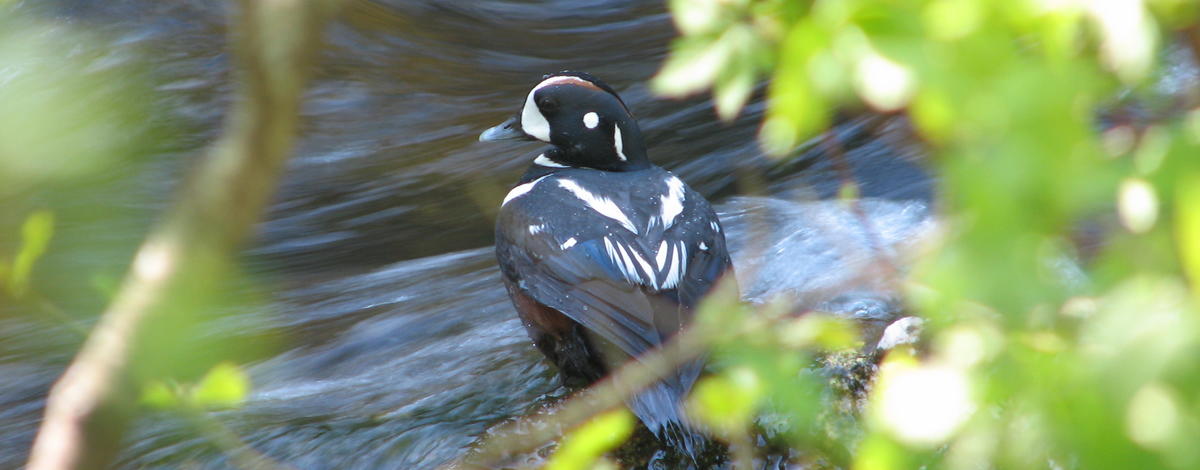The following topics are featured in the spring edition of "Windows to Wildlife" Idaho Fish and Game's quarterly wildlife newsletter.
IDAHO'S QUEST TO MONITOR ITS MOST MYSTERIOUS DUCK
In the remote and rugged stream scapes of Idaho's northern wilderness, a small but vibrant splash of color paddles against the current. The harlequin duck, a species as enigmatic as it is colorful, faces the scrutiny of biologists eager to unravel its mysteries. Known for their striking plumage and secretive nature, these ducks are the center of an important investigation aimed at determining whether their population in Idaho is holding steady or facing a decline.
Each year, as the chill of winter fades and the lush landscapes of Idaho's Panhandle and Clearwater regions burst into the greens of spring, pairs of harlequin ducks arrive from the Pacific Coast to their breeding streams. This marks the beginning of a vital period of observation carried out by the Idaho Department of Fish and Game and their partners at the U.S. Forest Service. In the spring and summer of 2023, these teams embarked on a series of 15 meticulous surveys across nine different stream sections, navigating the terrain by raft, foot, and road to monitor these elusive birds.
The surveys are timed strategically: First in May to count the adult ducks and identify potential breeding pairs, and again in the summer months to check for signs of new life as ducklings hatch and begin their journey into the wild. Despite the challenges posed by the rugged terrain and the duck's elusive nature, the teams were able to confirm the presence of at least seven adult harlequin ducks throughout the season.
Observations included a dedicated pair, solitary males and females, and a particularly heartening sight—a single brood of three ducklings shepherded by a vigilant female.
However, the job of tracking harlequin ducks is challenging. The terrain is tough, the ducks are few, and the data hard to come by, making reliable population estimates a complex puzzle. This has spurred on new scientific endeavors to improve how these surveys are conducted. Enter Holli Holmes, a graduate student from the University of Montana, who is at the forefront of developing innovative techniques that could revolutionize our understanding of these ducks. Holmes is experimenting with remote cameras and the collection of environmental DNA—an advanced method that could detect the presence of harlequin ducks without the need for direct observation.
Holmes's pioneering work has caught the attention of the media, with Montana Public Radio featuring her research. This collaboration between state, federal, and university researchers showcases a growing commitment to safeguarding the future of the harlequin duck. As the efforts to renew these survey methods continue, the hope is that more accurate data will lead to better conservation strategies, ensuring that harlequin ducks remain part of Idaho's natural heritage.
EXPLORING RIPARIAN RESTORATION: A FROG'S EYE VIEW
During the 2023 eld season, biologists from the Idaho Department of Fish and Game launched an intriguing project to study the presence of Columbia Spotted Frogs in riparian restoration areas along Hurry Back, Rose, and Long Tom creeks. This ambitious project was designed to evaluate how effective these habitat restoration efforts are in supporting populations of amphibians….
BUZZING ACROSS THE PACIFIC NORTHWEST
As the summer of 2023 drew to a close, so too did an era of discovery for the Pacific Northwest Bumble Bee Atlas (Atlas). In its sixth and final season of data collection, this ambitious project led by the Idaho Department of Fish and Game (IDFG) reached new heights of collaboration and conservation….
HOPE FLOATS FOR WESTERN GREBES AT LAKE CASCADE
In the shimmering waters of Lake Cascade, Idaho, a dramatic avian drama unfolds each year. The Western Grebe, a bird as elegant as it is vulnerable, plays the lead role in a story of survival and resilience. Known for their striking black-and-white plumage and captivating mating dances, Western Grebes are a species of great conservation concern…
ON THE TRAIL OF THE WESTERN RIDGED MUSSEL
In a sweeping series of expeditions across Idaho’s waterways, biologists from the Idaho Department of Fish and Game (IDFG) embarked on 15 detailed instream surveys in 2023. The mission? To monitor the state’s freshwater mussel populations, with a special focus on the Western Ridged Mussel…
FLIGHT OF THE MONARCHS: ENHANCING HABITATS AND TRACKING MIGRATION
In an innovative stride towards conservation, the Idaho Department of Fish and Game (IDFG) is pushing the boundaries of wildlife monitoring and habitat restoration to protect the migratory patterns of the Monarch Buttery (Danaus plexippus), a candidate species for listing under the Endangered Species Act. With monarch populations facing numerous threats, IDFG's approach integrates cutting-edge technology with traditional conservation practices, fostering an environment where these butteries can thrive…
TETON BASIN TRUMPETER SWAN RESTORATION
Once teetering on the edge of extinction, the Trumpeter Swan, North America's largest waterfowl, is staging a dramatic comeback. Historically hunted for their prized feathers, these magnificent birds faced severe threats that dwindled their numbers drastically. Yet, through concerted conservation efforts, including the establishment of wildlife refuges and legal protections, the Trumpeter Swan is reclaiming its place in the wild, particularly in the scenic expanses of Idaho…
See more at https://idfg.idaho.gov/sites/default/files/windows-to-wildlife-spring-2024.pdf

